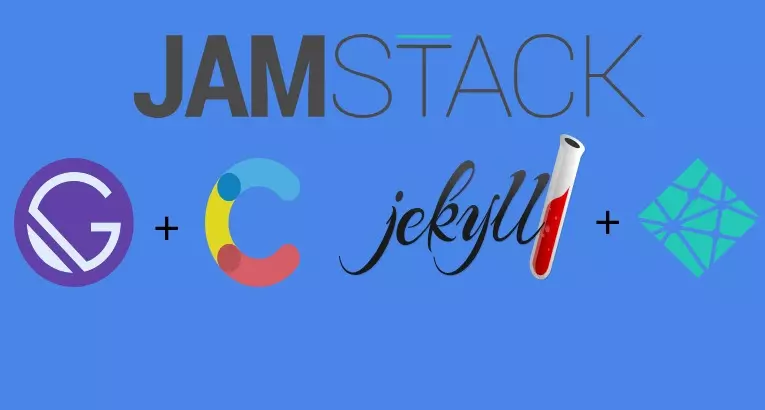Why JAMStack Websites are the Next Big Thing for Marketing Experiments
11 mins read.

In this article, I will define the new thing in marketing i.e JAMStack. I will mention how JAMStack can change how marketers run experiments and what are some tools and technolgies available for marketers to build JAMStack websites.
When I first wrote the blog post about building a Jekyll website, I never knew that JAMStack or static-site generators could be getting popularity among marketing community.
It wasn’t obvious to me until I witnessed a few marketers who use JAMStack for their personal and side experiments.
Boy, are we, as marketers, glad to have witnessed the popularity of JAMStack and static websites. It’s fair to say that at least I had had my fair share of experience working on such kinds of websites. I’m all for it, anytime!
Don’t get me wrong, I still love WordPress and use it at work. But I had my reasons for moving to Jekyll, which I wrote in Part 2 of “ Building a FREE website” article series. I felt that the community is in pretty good shape and it will only keep growing.
In this article, I would like to mention my thoughts on JAMStack and why I think it could be the next big thing for the Marketing community.
There are many options available for marketers for launching their marketing experiments, but only a few are scalable and cost-efficient. Although unscalable options have their place in building user acquisitions but if you want to run successful marketing experiments, you need scalability.
To answer it right up front, the scalable options to launch marketing experiments are:
Almost all the marketers and SEOs are familiar with either all or a few of the aforementioned channels. The very obvious reason why marketers choose one of these options to launch the marketing experiments and campaigns boils down to these things: money, developers, and marketing team.
Since this article is not to talk about all these platforms, but only one among them: JAMStack. Let’s dig into the meat of the matter already!
The word JAM in JAMStack refers to JavaScript, APIs, and Markup. For starters, here’s what these specific letters mean:
In simpler terms, JAMStack is a tech-stack that is referred to as a way to build static websites – a set of HTML files that represent an actual webpage. In general, static websites don’t involve rendering from a server, but a browser. Having said that, most of the back-end processing takes place in the user’s browser.
Moreover, since there is no involvement of server and backend, the scalability comes more naturally and conveniently. What’s more, JAMStack websites are by default secure as there is no scope of database and server security attacks.
Mathieu Dionne, the lead Marketer at Snipcart, defines it succinctly,
“JAMstack is a significant shift in focus from the now abstractable backend to the now powerful frontend.” - Mathieu Dionne
For marketers who are still new to this concept, here’s what JAMStack websites may have for you in-store:
If you are still finding it confused to understand the whole JAMStack idea, understanding the community around it might help.
There are hundreds of tools and technologies for building the JAMStack websites and the number only keeps on increasing.
For starters, here are definitely some technologies that stand out from others:
JS is everywhere, even in JAMStack. You might have probably heard the terms Single Page Applications (SPA) and Progressive Web Apps (PWA). There is a bunch of frameworks or libraries that help you to build those: Angular, React, and Vuejs. In the JAMstack, you will use these technologies to deliver safe, fast, and dynamic sites without relying on web servers.
Since you will be using these technologies in the frontend, here are some in-hand best-practices that you’d want to utilize:
For marketers, here are some of the benefits over the top of my mind:
However, not every tech stack is all sunshine and rainbows. Here are some downsides of using JAM Tech stack for marketers:
With JAMStack, you will be probably dealing with a lot of code. But it doesn’t mean that you are required to wear your developer hat every time and code all features manually. Luckily, some static site generators like Jekyll, Hugo, Pelican, Gatsby, etc. gives you the flexibility to implement basic functionalities like SEO without deeging deeper into code.
Although I wouldn’t deny the fact that it will need some developer skills upfront (and so does every framework, yes even our favorite WordPress!).
Okay. Let’s make it clear upfront: WordPress is a good choice for all of our marketing experiments since it is easy to set up and run. But it isn’t the only choice available. And I see no reason why it should?
Of course, it gives you the liberty to use plugins for even complex features like WooCommerce. But, think about it for a minute: is it convenient every time to increase your hosting limit every time your marketing experiment goes viral?
I have seen WordPress websites going down even if they hit 1000+ visitors at a time. Is this what you call scalability?
Now you would argue that hosting from a good service provider or even cloud will rarely hit the rock bottom in marketing experiments. Yes, I’ll give you that!
But what’s with this search for a good hosting provider that you as a marketer should bother about? Think about this!
Besides, an average WordPress website needs about 20-30 plugins. Some of these may even slow down your website loading speed: read here and here.
Sure, it makes sense to use these plugins since not everything needs manual implementation. Makes sense! But if using plugins hinders your marketing experiments and growth, who’s to be blamed?
JAMStack websites are easy to build and host your content. Most importantly, they give you the benefit of speed and scalability. The options to host your web pages are numerous with GitHub Pages, Netlify, or Zeit being popular ones.
With JAMStack, you can always integrate CMS to enjoy basic facilities like adding editor roles, managing user permissions, and adding content. There are tools like Netlify CMS, Headless CMS, and Contentful for that.
Since your end goal is building websites that are good for marketing experiments, it’s recommended to use any CMS that has a robust API to send content to your site. In this way, you can store all of your content in a CMS even if you are not a fan of using GitHub Pages. In general, CMS like Netlify and headless can be easily integrated with whatever frontend stack you are using, and for static websites, you might also want to use static-site ready CMS options like Siteleaf and Forestry. Your options are endless, so you might as well want to google them and read about them.
For marketers, here are some options that can be part of your JAM Tech stack:
Gone are the days when web used to be boring and slow. Today’s users expect the browsing experience as seamless and smooth. Forget slow load times, now your users truly value the secrecy and privacy of their confidential information.
Things Change! As we move closer to an era of all-things-digital, the way we approach marketing and user’s expectations also changes.
If you are not offering a good and engaging experience to your user, you are probably missing out on something very important. As marketing becomes more complex, the metrics like speed, performance, and scalability are more critical than ever.
Sure, JAMStack can be an infancy term for marketers but I see a huge potential in it to go mainstream and become a part of our tech stack. I would recommend you to try the JAMStack for atleast one of your marketing experiment and analyze the results.
Till then, Sayonara! Thanks for reading.
